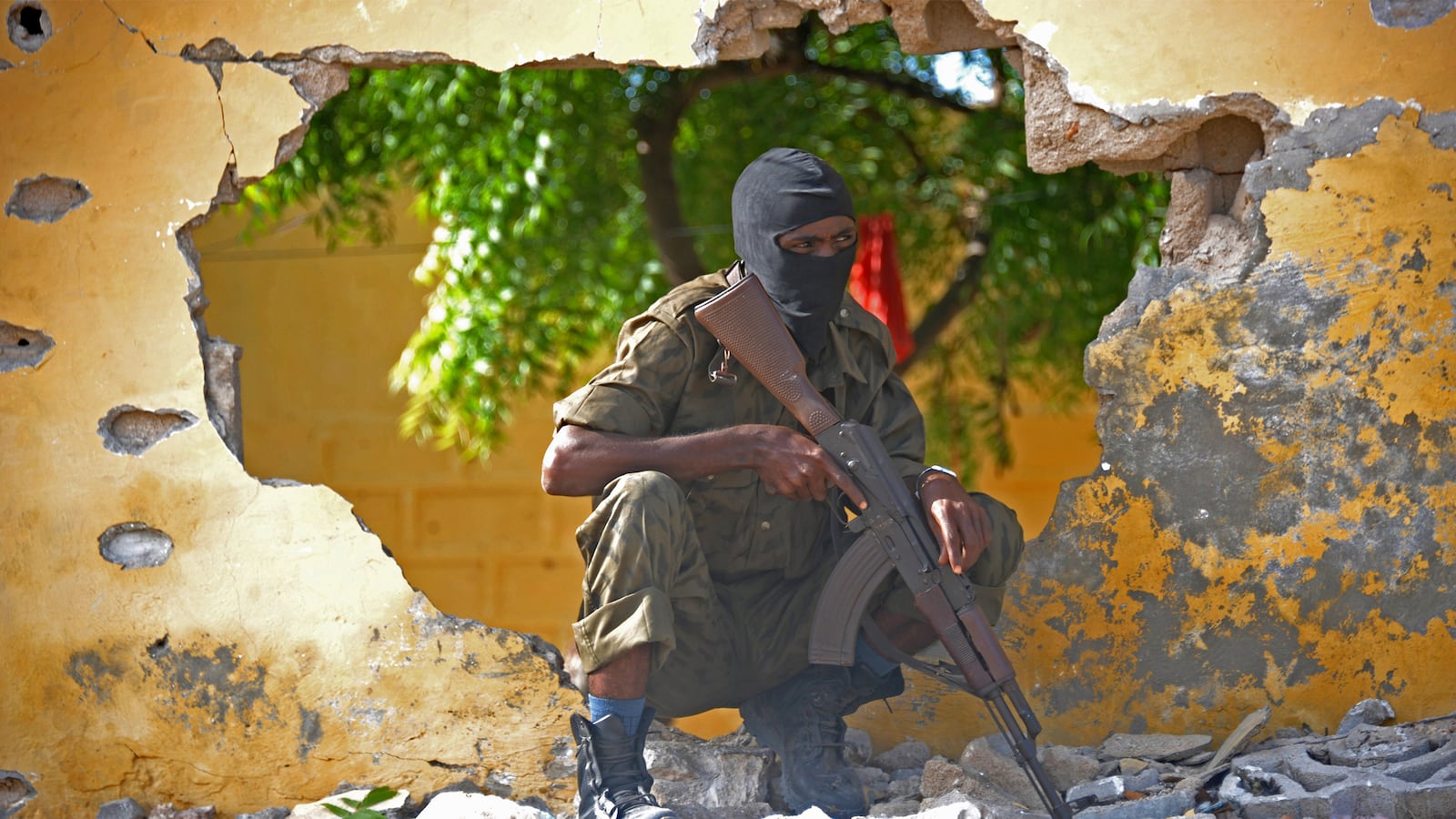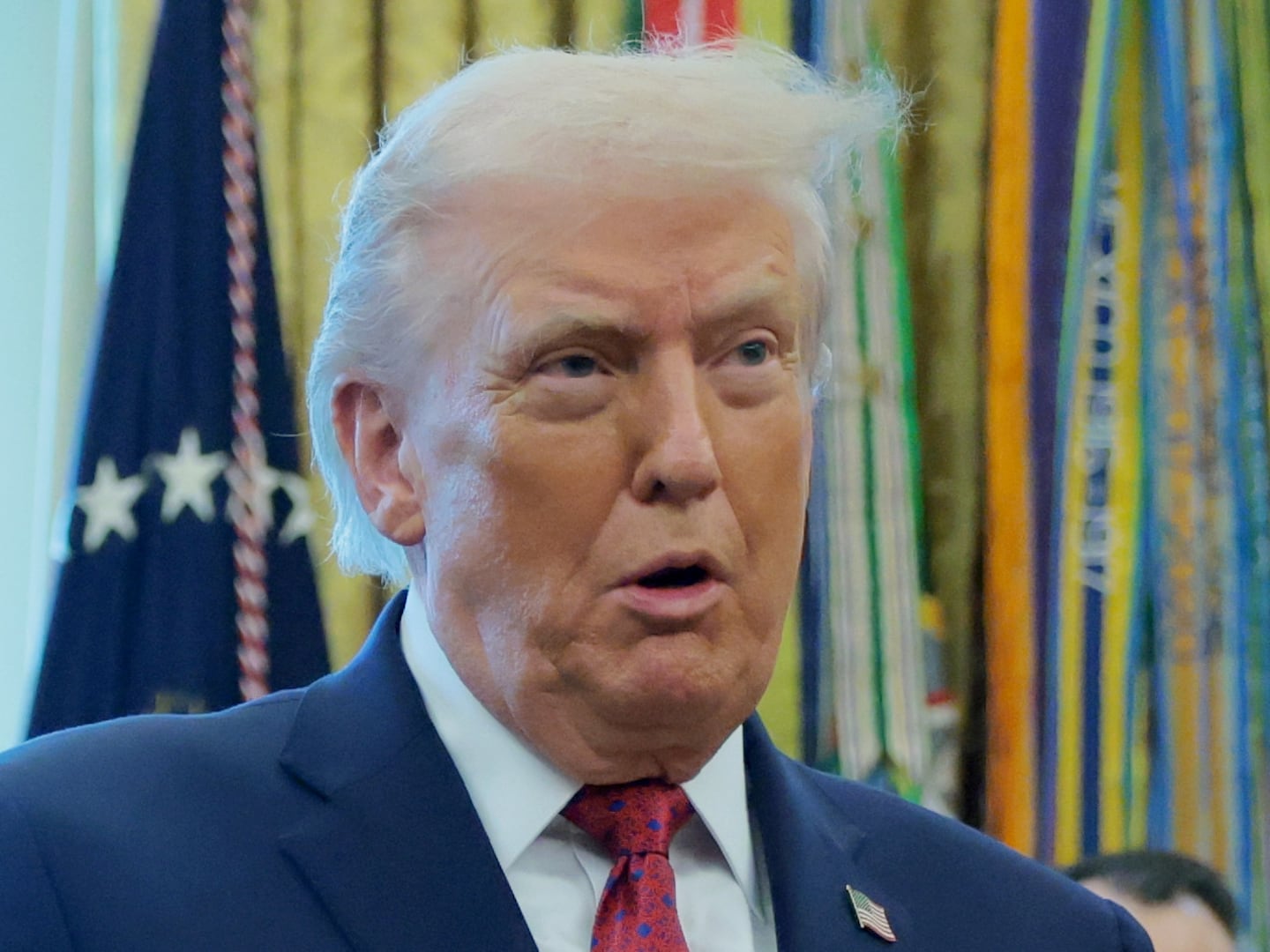Al-Shabaab, the al Qaeda-aligned militia in Somalia, is experiencing some of the most successful months of its recent history. Until recently, many had been tempted to suggest that the group was on its last legs as it faced a seemingly overwhelming military force in the form of the African Union Mission in Somalia (AMISOM)—a Western-backed coalition of East African militaries tasked with fighting al-Shabaab and supporting the Somali National Army (SNA). While this has succeeded in removing al-Shabaab from the most strategically important urban areas of the country, including the capital Mogadishu and the port city of Kismayo, the mission has begun to falter. Troops appear to be overstretched and lacking direction in the face of a number of major setbacks as al-Shabaab pursues a dual strategy of traditional insurgency and terrorism.
While it is tempting to refer to an al-Shabaab resurgence, this is also slightly misleading. Instead, we are witnessing what many close observers of the Somali conflict have seen coming for quite some time: a well-organized, disciplined and ideologically committed militia which is deeply embedded in certain key parts of the country now seizing its opportunity during a moment of weakness for its enemies.
Western security agencies have had their heads turned by ISIS, and at a time when AMISOM requires increased support, it is experiencing the opposite. In February, for example, the European Union, which funds AMISOM activities as part of a financing agreement called the African Peace Facility, announced a 20 percent reduction in its financial support which covers troop allowances. While the threat to Western security posed by ISIS certainly justifies the increased attention it is now receiving, governments cannot afford to take their eye off the ball in Somalia as a result.
A recent missile strike on an al-Shabaab base by the American military, which reportedly killed a staggering 150 fighters, suggests that the group is still considered a significant terrorist threat. However, it has proved resilient to these attacks in the past, and hard power alone cannot defeat it. This type of strike, while undoubtedly a blow, also plays into al-Shabaab’s hands as it strives to present itself as the protector of Somalis and Islam from dangerous foreign influences.
High-profile urban bombings and military raids on AMISOM bases throughout the country have become an almost weekly occurrence. February was a particularly busy month, and one which began with one of al-Shabaab’s most high-profile terrorist attacks when a member of the group detonated an explosive on a Daallo airlines jet leaving Mogadishu for Djibouti City. The incident received relatively scant media attention in the West, likely due to the attacker’s failure to kill anyone but himself when his bomb tore a hole in the fuselage, blowing him clean out of the aircraft. However, this should not simply be laughed off; the bomb, which was built into a laptop, demonstrated that the group retains its ability to build sophisticated devices. The attacker, who was likely assisted by staff at Mogadishu airport, also had the wherewithal to outsmart security and place the bomb on an international airliner.
This came just weeks after the group’s first major terrorist attack of the year, when a suicide bomber and at least eight gunmen stormed a beach-front hotel in Mogadishu, killing around 20 civilians. Al-Shabaab ended the month with a high-profile assassination in Mogadishu, using a car bomb to assassinate former Somali defense minister Muhidin Hassan Haji in Mogadishu, and carrying out coordinated bombings and shootings both in the capital and in the southern town of Baidoa which killed around 40 people.
Outside of the urban centers, al-Shabaab’s prowess as a traditional insurgent force fighting members of AMISOM has also been on display. In January, the group overran a Kenyan Defence Force (KDF) forward operating base in el-Adde, southwestern Somalia. The raid, which led to the death of at least 100 Kenyan troops, inflicted the single worst loss of life in the country’s military history. In February, it briefly took control of the strategic port town of Marka after seeing off AMISOM forces based there, and temporarily seized the town of Afgoye from the SNA, only 30km from Mogadishu. These and many other such raids have not only been strategic and propaganda coups for the group, but have also allowed it to seize large amounts of military hardware from AMISOM and SNA troops, including military vehicles, assault rifles and ammunition.
The short answer is that al-Shabaab was never defeated, and that any claims to the contrary were overly-optimistic and ignored both how embedded al-Shabaab remains in Somalia, and the limitations of those opposing it. Many assessments also mistakenly measured the group’s capabilities solely on how much territory it controlled, ignoring its size and cadres of experienced and hardened fighters. The most conservative estimates of al-Shabaab’s membership stand at around 6,000, while other reliable sources have suggested that the group’s force is more than double this. While it is difficult to confirm these figures, if that number stands anywhere near the higher estimates, AMISOM’s force of 22,000 is simply not enough to achieve anything resembling a victory. The SNA boasts another 20,000 troops, but they are not yet experienced or well-trained enough to have the desired impact.
While AMISOM and SNA forces have succeeded in ensuring that al-Shabaab no longer controls major urban centers, they have struggled to capitalize on short-term successes in rural towns and regions and shown little interest in pursuing any sort of coherent political or military strategy. Their military gains often follow a similar pattern; troops oust al-Shabaab from a district or town and, like any good insurgency, the militia melts away into either the local population or surrounding forests, bides its time, and returns once troops have moved on. The mission has failed to remove the group from any of its rural hideouts (often found in the dense forests of Southern and central Somalia), and AMISOM soldiers in particular rarely patrol outside of their bases, leaving al-Shabaab the freedom to operate with ease among the local population and present itself as a viable alternative to the Federal Government of Somalia (FGS).
The recent struggles faced by AMISOM are not only a matter of a lack of resources and a clear strategy. The political climate in Somalia is deeply fractured and dysfunctional, leading to an increased lack of trust between the FGS and the wider population. The government has little control outside of its base in Mogadishu and its military is viewed with distrust among many who see it as a tool for various competing clans to gain influence.
Among the most significant political challenges in Somalia is an ongoing political standoff between the FGS and the administrations of the semi-autonomous regions of Puntland and Jubbaland over the framework model for the presidential elections set to be held in September. Leaders of both regions have rejected proposals by the government to use a hybrid election model based on the controversial and outdated 4.5 power-sharing formula, which empowers the four major Somali clans while marginalizing many others. While the UN has also intervened in the discussions, it has not yet succeeded in helping to strike a deal.
This political paralysis has, among other things, led to a lack of security cooperation and coordination between the center and periphery which has greatly benefitted al-Shabaab, allowing it to regroup. It has also taken the opportunity afforded by this standoff to mobilize marginalized and disaffected communities against the government and its regional administrations.
This all comes during a period when al-Shabaab has undergone a change of leadership, with a new regime seeking to assert itself in the face of internal discord and threats to its control over the group. Until September 2014, it was led by Ahmed Abdi Godane, a confidant of Osama bin Laden’s and veteran of the Afghan jihad. He helped oversee the strengthening of ties between al-Shabaab and al Qaeda, a relationship that was formalized in February 2012 by Aymen al-Zawahiri, by the then-new head of the global terror network. Godane’s strong al Qaeda connections helped to inform the decision made to target him as part of President Obama’s drone program, and he was killed by a missile strike in September 2014.
During Godane’s final years, al-Shabaab had begun to prioritize terrorist attacks on neighboring East African countries which formed part of AMISOM. His replacement, a close associate named Ahmad Umar, has taken the group in a slightly different direction. His predecessor’s approach led to accusations that he was losing sight of the group’s national narrative, and Umar has placed renewed emphasis on gaining domestic support through a strategy of increased insurgent and terrorist activity within Somalia. Since his ascension, he has however struggled to gain full support across the group and the recent wave of attacks may also be part of an effort to prove his doubters wrong.
While al-Shabaab still targets countries like Kenya, it has therefore scaled up its domestic attacks, and scaled down its external focus. Successful terrorist attacks and raids on AMISOM bases, seen by many Somalis as symbols of foreign occupation, are helping to draw more recruits and convince some that al-Shabaab’s model of a Somali Islamic State is the country’s best hope for self-determination and a functional government.
Umar’s rise to power has also coincided with the increased global popularity of the Islamic State among global jihadists. As a result, he has faced calls both from within al-Shabaab and from ISIS to switch allegiances to the supposed new Caliph, Omar al-Baghdadi. Within months of Umar’s appointment, ISIS began releasing videos either urging al-Shabaab to switch allegiances, or depicting small breakaway factions in Somalia pledging their loyalty to the new Caliphate. The most high-profile defection to date came in October last year when Abdiqadir Mumin, an al-Shabaab cleric based in Puntland, swore his fealty to Baghdadi. While much was made of this at the time, this defection amounted to roughly 20 of his followers and did not represent a significant blow to the al-Shabaab leadership.
Nonetheless, ISIS does undoubtedly have some appeal among younger members of al-Shabaab and its members from the Somali diaspora. While a Syrian-Iraqi jihadist group is very unlikely to succeed in Somalia, al-Shabaab’s recent activities may also be part of attempts by the leadership to demonstrate its effectiveness as a weapon against the Western-backed war on Islam so that it may win over and prove itself to Somali ISIS sympathizers.
While it has proven very effective on the battlefield, al-Shabaab’s success can also be partly attributed to its sophisticated propaganda efforts. In the age of ISIS, it is easy to forget that al-Shabaab was among the first global jihadist militias to establish an Islamic state and produce well-edited propaganda videos heralding its success and calling upon the world’s Muslims to join its cause. Indeed, before Syria became the destination du jour for Western jihadists, it was Somalia that attracted many Western foreign fighters, due in part to gains it made during the end of the last decade. It was also among the first jihadist groups to see the benefits of a social media presence, and set up an official Twitter account long before ISIS and its supporters had emerged on the platform.
While al-Shabaab avoids depicting the ultra-violence which has come to define the more headline-grabbing elements of ISIS media output, it still regularly produces propaganda. This includes video reports from the frontlines (the group has even been known to stage attacks the sole reason of filming them for propaganda purposes) and examples of their provision of social welfare to rural Somalis.
There are two main media centers which produce and distribute al-Shabaab propaganda to a variety of audiences. Radio Andalus and a number of its affiliates create output in Somali for the local population which focuses on domestic and local concerns. The group draws many of its recruits from among rural and disfranchised communities in Somalia and its messaging to this population focuses on al-Shabaab’s ability to provide them with the resources and infrastructure which the state has failed to deliver in many regions.
In February, al-Shabaab released photographs claiming to depict the provision of medical aid to farmers and their livestock in the Lower Shabelle region. Another release that same month purported to show members of al-Shabaab’s self-styled aid agency assisting residents of the hotly contested town of el-Adde, who it had claimed were the victims of AMISOM airstrikes launched in response to the group’s successful raid of the KDF base in January.
However, if you have ever watched an al-Shabaab video, chances are it came from al-Kataib, an al Qaeda production entity which creates videos for a foreign audience. Thus, this output is rarely in Somali, and is usually found in Arabic, English and Swahili. The Arabic propaganda is usually aimed at potential funders in the Gulf, who have in the past been known to send money to the group and were previously involved in buying charcoal from al-Shabaab when it was in control of the port of Kismayo.
The English-language videos target both members of the Western Somali diaspora who aspire to join the group as foreign fighters, along with others in the West who may either wish to join, or even more importantly for al-Shabaab, fund the group’s activities. Since the rise of ISIS, al-Shabaab has been more focused on the latter, with very few, if any, non-Somali Western jihadists looking beyond the newly established Caliphate in the Levant.
The group has, however, succeeded in gaining membership from closer to home, and its Swahili videos seek to encourage the recruitment of East Africans, in particular Kenyans. The results of this recruitment drive mean that Kenya now faces the biggest terrorist threat in its history. It has already suffered a number of major attacks which Kenyan recruits have participated in, from the Westgate mall shootings in 2013, to the more recent massacre at a university in the North-Easter town of Garissa. Unfortunately, despite Umar’s renewed focus on operations inside Somalia, it is likely that Kenya will remain firmly in al-Shabaab’s cross-hairs, with another major attack seemingly only a matter of time.
Considering the focus of this analysis, it is easy to be pessimistic about the future of Somalia, but it is important not to ignore the significant strides that the nation has made. Take, for example, the return of the Somali diaspora to the country, who are bringing with them the skills and innovation required for the reconstruction of the country. This seems to be paying dividends, and a recent survey by IMF has shown remarkable progress in economic growth over recent years.
A political solution is the only way to truly end this conflict. Progress is slow, but Somalia’s federalization process, despite many ongoing challenges, has seen the creation of various semi-autonomous states and helped stabilize the country. Keeping these gains intact would require, first and foremost, a solution to the country’s fragmented politics and more investment in building a genuine national Somali force rather than the current over-reliance on foreign troops.
It is also encouraging that, despite its recent gains in Somalia, al-Shabaab is no longer the force it was in Somalia during the previous decade and likely never will be again. However, this should serve as one of a number of reminders that al Qaeda remains a potent force in the world. While it does not have control over the strategy or day-to-day operations of al-Shabaab, al Qaeda is still revered by many within the leadership who will continue to assist in any way they can. While at present al-Shabaab lacks both the interest and capabilities to plot terrorist attacks in the West, it retains its alliance with Yemen’s al-Qaeda in the Arabian Peninsula (AQAP). This organization still poses a very real international terrorist threat, and most recently is thought to have trained and deployed the Koachi brothers, who gunned down staff in the Paris offices of Charlie Hebdo magazine in January last year.
It is therefore unsurprising that the group remains a major target for American counter-terrorism authorities, but more effort must be made to bolster the effectiveness and legitimacy of the FGS and SNA, and in the short term assist AMISOM in developing a more comprehensive counter-insurgency strategy. Until this changes, al-Shabaab will continue to de-stabilize Somalia and remain a serious threat to African and Western interests.






